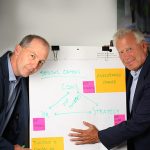Are You Missing The Obvious?

Leadership
October 12, 2018
Jim Haudan and Rich Berens
Topics
blind spots, Change, employee engagement, Jim Hauden, Rich BerensTraditionally the phrase “blind spot” refers to a part of the retina that is insensitive to light, which results in an actual spot in the eye where a person can’t see. “Blind spot” is also a phrase used when the side mirrors of a car create a space to the left and right side of your vehicle where you can’t see cars passing or driving next to you.
Just as we have visual blind spots and societal blind spots, we have found, in our 20+ years of working with many of the largest companies across all industries around the world, that there are leadership blind spots.
Leadership blind spots are areas where our existing beliefs and experiences preclude us from having the most enlightened view of how to lead most effectively.
The research that linked smoking to cancer and sugar-filled, carbonated drinks to obesity wasn’t always obvious. But if you take the time to reconcile data with reality, you can embark on a trajectory of profound belief challenge and change. In short, you can overcome a particular blind spot.
As we’ve shared in previous posts, there are a series of five leadership blind spots that cloud how we lead and run organizations and the people in our organizations.
These blind spots are just as absurd as concepts such as bloodletting and healthy smoking habits; and, like those societal blind spots, we aren’t aware yet of how flawed our thinking is when it comes to our leadership.
WHY THESE BLIND SPOTS MATTER
The stakes are high, as the realities of today’s workplace scream for an intense examination of the core beliefs from which all leaders lead and engage their people. We know that 60 to 90 percent of all strategies are not executed, 70 percent of people in organizations are not actively engaged, and as a result, more than a half trillion dollars’ worth of economic value is not realized in the United States alone annually.
If ten people from your organization or team were in a tug-of-war with the competition to win more customers and grow your business, data tells us that, while three people are pulling as hard as they can to win, five of your people are not pulling at all—they are pretty much indifferent. And two people are trying to cut the rope with a knife and set the rope on fire at the same time! This isn’t a pretty picture, but it’s an accurate representation of most workplaces today. Studies show that 50 percent of the people are indifferent, 20 percent are actively disengaged or are arsonists, and a mere 30 percent are actively engaged. What’s even worse is that this picture has not changed for 30 years. According to Gallup’s annual employee engagement polls, there has been no significant movement in engagement scores in the last 30 years. That data is staggering!
So what can we do to facilitate change?
The first step, and typically the hardest, is realizing and accepting the fact that this disengagement is not your people’s fault. Most professionals don’t wake up each day and say:
- “I can’t wait to not make a difference today.”
- “I am indifferent about what we do as a company. Just pay me.”
- “My goal for the next year is to be average at best!”
The great majority of us don’t want to think this way about the place where we spend more time than anywhere else in life—and yet way too many of us feel that way. While all employees should own their engagement, the truth is that the tone, conditions, and environment in which those same employees could thrive or become disengaged are set by leaders. Change has to start with leaders, and it has to be about owning and creating the conditions for high engagement and high performance.
One of the greatest untapped opportunities in business today is to access the dormant human capital that we often fail to capture and inspire. With only 30 percent of professionals being engaged, the vast majority of human talent is not showing up at work to innovate, create, build, change, and find better ways of doing things. As leaders, we simply can’t accept that.
It’s time to look in the mirror to get at the root causes of this challenge and uncover blind spots in order to create a better way of leading.






